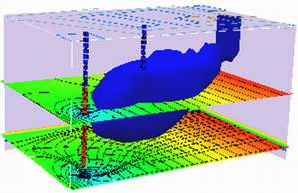Unsaturated Zone Transport¶
Unsaturated Zone Flow and Transport refers to the movement and transport of water and contaminants in the portion of the subsurface that lies above the groundwater table and contains both air and water within the pore spaces of the soil or rock. In this zone, the pore spaces are not completely saturated with water; rather, they contain a mixture of air and water, with the degree of saturation varying depending on factors such as rainfall, evaporation, and soil properties.
The unsaturated zone, also known as the vadose zone, is a critical component of the hydrological cycle. Water moves through this zone due to gravity, capillary forces, and pressure gradients. It plays a crucial role in processes like soil moisture replenishment, plant root uptake, and filtration of contaminants. Understanding unsaturated zone flow and transport is essential for managing water resources, assessing the risk of groundwater contamination, and optimizing land use practices to protect both water quality and quantity.
Volatile Emission from Soils¶
pp. 305-308 of textbook discusses
Vapor Transport¶
pp.308-315 discusses vapor transport concepts
Vadose Zone Flow and Transport Models¶
pg 315-330 of textbook discusses models
